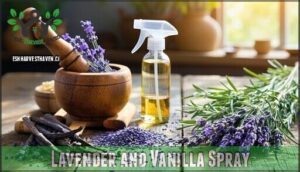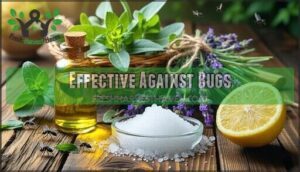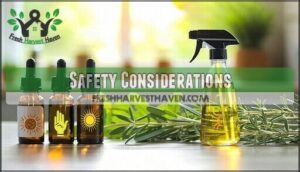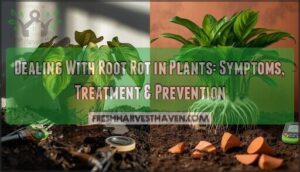This site is supported by our readers. We may earn a commission, at no cost to you, if you purchase through links.
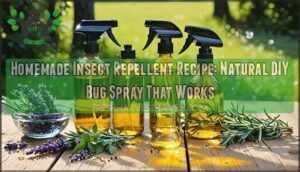
You can mix essential oils like citronella, lemongrass, or tea tree oil with EPA-approved ingredients to create a natural DIY bug spray.
By making your own homemade insect repellent recipe, you control what goes on your skin, and it’s often more effective against bugs than commercial products, giving you peace of mind when outdoors.
This approach allows you to customize the ingredients, ensuring a smell you like, and that’s just the beginning of creating your perfect bug spray, with the added benefit of being a natural DIY solution.
Table Of Contents
- Key Takeaways
- Natural Insect Repellents
- DIY Bug Spray Recipes
- Homemade Repellent Benefits
- Safety Considerations
- Using Homemade Repellents
- Frequently Asked Questions (FAQs)
- What is the best homemade insect repellent?
- What scent will keep insects away?
- What smell will keep all bugs away?
- Does Dawn and vinegar keep bugs away?
- What mixture keeps bugs away?
- What smell do all bugs hate the most?
- What is a natural spray to keep bugs out of your house?
- How do you make homemade bug repellent?
- How do you make a blended insect repellent?
- Is there a homemade bug repellent?
- Conclusion
Key Takeaways
- You’ll create effective natural bug sprays using essential oils like citronella, lemongrass, and tea tree oil mixed with witch hazel or vinegar, giving you complete control over ingredients and scents.
- You need to dilute essential oils properly (10-15 drops per tablespoon of carrier oil) and avoid phototoxic citrus oils like bergamot and lime when you’ll be in sunlight.
- You’ll get maximum protection by reapplying your homemade repellent every 2-3 hours, especially after sweating or swimming, since natural ingredients don’t last as long as synthetic chemicals.
- You should store your DIY repellent in dark-colored bottles away from heat and sunlight to prevent ingredient degradation and maintain effectiveness longer.
Natural Insect Repellents
You don’t have to rely on harsh chemicals to keep bugs at bay when nature provides effective alternatives.
Natural insect repellents use essential oils and plant-based ingredients that work just as well as commercial products while being gentler on your skin and the environment, making them a more natural choice.
Natural insect repellents offer a gentler choice for skin and environment
Essential Oils for Repellent
Essential oils pack serious punch against bugs, but you’ll need the right Oil Combinations and Carrier Oils to make them work.
Lemon eucalyptus oil delivers CDC-approved protection, while citronella and peppermint create effective essential oil blends.
Oil Potency varies by Extraction Methods—steam-distilled oils often outperform solvent-extracted versions.
Mix essential oil recipes carefully, diluting 10-15 drops per tablespoon of carrier oil for safety.
For pets, it’s best to avoid essential oils and instead consider using safer alternatives like hydrosols for a natural bug repellent.
Plant Based Repellents
Plant-based repellents harness nature’s own defense mechanisms against pests.
You’ll find herbal infusions made from mint, basil, and lavender provide natural protection. Vinegar repellents combine apple cider vinegar with sage and thyme for potent results.
Your spice cabinet offers cloves and peppermint for DIY insect repellent formulations. Castile soap creates gentle yet effective natural insect repellent solutions. Tincture recipes using vodka extract insect-repelling herbs for longer-lasting protection.
These options align with the growing demand for natural insect control.
EPA Approved Ingredients
While plant-based options offer natural protection, the EPA registration process guarantees repellent safety and effectiveness through rigorous testing.
The approved ingredient list includes proven compounds that undergo regular re-evaluation programs and safety data sheets review.
Key EPA-approved natural ingredients include:
- DEET – Found in over 500 registered products with decades of safety data
- Picaridin – Used in approximately 40 EPA-approved formulations
- Oil of lemon eucalyptus – Effective against mosquitoes carrying Zika and West Nile
- IR3535 – Registered in about 45 skin-applied products
- Catnip oil – Recently approved with strong mosquito repellency
EPA guidelines require demonstration of both human safety and effectiveness before registration, addressing inert ingredient concerns through thorough evaluation.
DIY Bug Spray Recipes
You can create effective bug sprays using simple ingredients from your kitchen and essential oils. These homemade recipes target specific pests while letting you control what touches your skin.
Create your own bug sprays with simple kitchen ingredients and essential oils for natural protection
Citronella and Lemongrass Spray
Citronella and lemongrass are your dynamic duo for a homemade bug repellent that actually works.
Citronella benefits include masking scents that attract mosquitoes, while lemongrass properties offer a fresh, zesty defense.
For spray effectiveness, blend these essential oils with witch hazel or alcohol. Citronella lemongrass options are readily available.
Recipe variations depend on sourcing ingredients, but DIY mosquito repellent lets you control every detail.
Tea Tree Oil Spray
You’ll love the Tea Tree Oil Spray, a natural insect repellent.
Mix tea tree oil with water for a DIY mosquito repellent, considering Tea Tree Benefits and Tea Tree Dilution for safety and efficacy, making it a great homemade insect repellent alternative.
Lavender and Vanilla Spray
You’ll enjoy the Lavender and Vanilla Spray, a soothing homemade insect repellent recipe.
Combine lavender oil properties with vanilla extract benefits for a calming scent combination effect, creating a unique insect repellent recipe with essential oils like lavender and vanilla extract.
You can also try companion planting techniques for broader pest control.
Homemade Repellent Benefits
You can create a homemade insect repellent that’s customizable to your needs, using natural ingredients like essential oils and herbs.
By making your own repellent, you’ll have control over the ingredients and can guarantee it’s effective against bugs while being gentle on your skin.
Customizable to Your Needs
You can tailor your homemade insect repellent recipe to suit your needs by making ingredient swaps, adjusting scent preferences, and tweaking strength for specific bugs.
Allowing for recipe tailoring with essential oils in your DIY bug repellent, creating a customized natural bug spray.
Smells Amazing
You’ll appreciate the pleasant scents of fragrance combinations in your homemade insect repellent, offering aromatherapy benefits.
Essential oils like citronella create a natural bug spray with a masking odor, catering to your scent preferences, making this insect repellent recipe a great alternative to commercial products with natural bug spray benefits.
Effective Against Bugs
You create an effective insect repellent using repellent ingredients.
- Citronella oil for mosquito repellent
- Lemon eucalyptus for tick repellent
- Peppermint oil for bug species
- Lavender oil for homemade insect repellent recipe potency.
A simple mix of dish soap and oil offers natural pest control for effective and natural insect repellent purposes.
Safety Considerations
You’re making your own insect repellent, so it’s vital to think about safety precautions.
As you create and apply your homemade bug spray, you’ll want to be aware of essential oil precautions, skin application guidelines, and potential phototoxic effects to safeguard safe use.
Essential Oil Precautions
When using essential oils in insect repellents, consider Dilution Guidelines and Allergy Testing for skin safety, while also addressing Pet Safety, Pregnancy Concerns, and Child Safety to avoid allergic reactions and phototoxicity.
| Precaution | Description |
|---|---|
| Dilution | Avoid skin irritation |
| Allergy | Test before use |
| Pet Safety | Consult veterinarian |
| Pregnancy | Avoid certain oils |
It is important to understand proper oil concentrations for safe use.
Skin Application Guidelines
When applying homemade repellents to your skin, remember to follow dilution guidelines to avoid reactions.
Patch testing is essential, especially for sensitive skin.
Always prioritize skin safety with proper dilution ratios and consider sunscreen use to guarantee safe topical application and prevent adverse skin reactions.
Phototoxic Essential Oils
Some citrus oils pose serious sun sensitivity risks due to furanocoumarins that trigger phototoxic reactions. These compounds cause severe burns when exposed to UV light, making certain essential oils dangerous for outdoor insect repellent use.
Citrus Oil Risks to avoid:
- Bergamot – Most phototoxic, requiring only 0.4% dilution for safe use
- Lime (cold-pressed) – Contains high oxypeucedanin levels causing burns
- Bitter orange – Triggers intense inflammation within 24-72 hours
- Lemon – Up to 20-fold potency variation depending on source region
- Grapefruit (cold-pressed) – Steam-distilled versions are safer alternatives
Application Timing matters: avoid sun exposure 12-24 hours after applying phototoxic oils. Dilution Importance can’t be overstated – proper ratios prevent severe reactions.
Choose Safe Alternatives like lavender or geranium for outdoor natural insect repellent formulations to protect your skin health. For general pest control, consider essential oil pest control for broader applications.
Using Homemade Repellents
Creating your own natural bug spray puts you in control of what goes on your skin and into your environment.
Once you’ve mixed up a batch, proper application and storage techniques will maximize its effectiveness and help you get the most out of your homemade repellent.
Application and Reapplication
Anyone can master the art of applying DIY bug spray with proper timing and technique.
Apply every two hours during active outdoor periods, focusing on exposed skin areas while avoiding eyes and mouth.
Reapplication becomes essential after sweating, swimming, or increased activity levels.
| Application Area | Frequency Guidelines |
|---|---|
| Exposed skin | Every 2 hours |
| Clothing application | Once per outing |
| Sensitive skin areas | Test first, apply sparingly |
| High activity levels | Reapply after sweating |
| Post-water exposure | Immediate reapplication needed |
Your homemade repellent works best with consistent coverage.
Remember that natural ingredients don’t last as long as synthetic chemicals, making regular reapplication your best defense against bug bites.
Storage and Shelf Life
You store homemade insect repellents in ideal containers, such as dark-colored bottles, to minimize Temperature effects and Sunlight exposure.
This helps prevent Ingredient degradation, thereby Extending shelf-life.
A simple mix of dish soap and oil can also be used.
Consider:
- Cool storage
- Darkcolored bottles
- Insect repellent storage to maintain effectiveness.
Traveling With Homemade Repellents
When traveling with homemade bug repellent, check TSA guidelines and international regulations.
Prevent leakage and guarantee shelf-life stability.
Apply frequently, considering essential oils and insect repellent storage safety to keep your homemade bug repellent effective during travel.
Frequently Asked Questions (FAQs)
What is the best homemade insect repellent?
Imagine a bug-free paradise; you’ll find it with a mix of lemon eucalyptus, citronella, and lavender oils, creating a potent, natural repellent to keep insects at bay, safely and effectively.
What scent will keep insects away?
You can use scents like citronella, lemongrass, or lavender to keep insects away, as they’re known to repel mosquitoes, ticks, and other bugs effectively.
What smell will keep all bugs away?
Like a shield, citronella, lemon eucalyptus, and lavender oils will keep bugs at bay, you’ll find these scents effective in repelling most insects, providing you some peace outdoors.
Does Dawn and vinegar keep bugs away?
You can try mixing Dawn and vinegar to keep bugs away, as the soap and acid may deter them, but effectiveness varies depending on bug type and concentration.
What mixture keeps bugs away?
A shield of protection, you’ll find that citronella, lemon eucalyptus, and lavender oils mixed with witch hazel or vinegar keep bugs at bay, offering you a bug-free haven outdoors.
What smell do all bugs hate the most?
You’ll find that bugs generally hate the smell of citronella, lemongrass, and lavender, which are often used in insect repellents to keep them away effectively.
What is a natural spray to keep bugs out of your house?
While bugs invade, you can mix citronella, lemongrass, and rose geranium essential oils with water to create a natural spray that keeps them out of your house effectively.
How do you make homemade bug repellent?
You can mix witch hazel, essential oils like lemongrass or citronella, and apple cider vinegar to create a natural bug repellent spray for personal use.
How do you make a blended insect repellent?
Like a master chef, you’ll blend citronella, lemongrass, and lavender oils with witch hazel and water to create a potent, skin-safe insect repellent that’s easy to apply and effective.
Is there a homemade bug repellent?
You’ll find several effective homemade bug repellent recipes using common ingredients like witch hazel, essential oils, and apple cider vinegar that naturally deter mosquitoes and other insects.
Conclusion
Studies show that commercial insect repellents contain an average of 12-15 synthetic chemicals, while your homemade insect repellent recipe uses just 3-5 natural ingredients.
You’ve learned to create effective, customizable bug sprays using essential oils like citronella, lemongrass, and tea tree oil. These natural alternatives protect your skin from harsh chemicals while providing reliable pest protection.
Remember to reapply every 2-3 hours and store properly for maximum effectiveness. Your DIY approach gives you complete control over ingredients and scent preferences.
- https://www.diynatural.com/homemade-insect-mosquito-repellent/
- https://wellnessmama.com/natural-home/homemade-bug-spray/
- https://dontwastethecrumbs.com/2015/05/homemade-bug-repellent-essential-oils/
- https://www.epa.gov/insect-repellents/deet
- https://www.pntrac.com/t/TUJGR0ZGSEJGRktJTkpCRkxNSUlI?url=https%3A%2F%2Fwww.planttherapy.com%2Forganic-lavender-essential-oil%3Fv%3D2949



